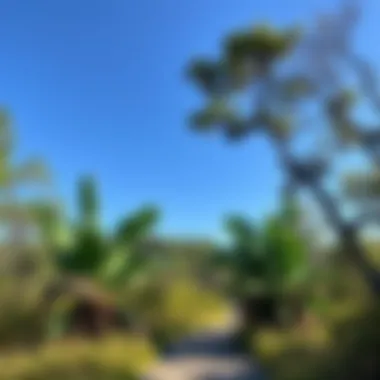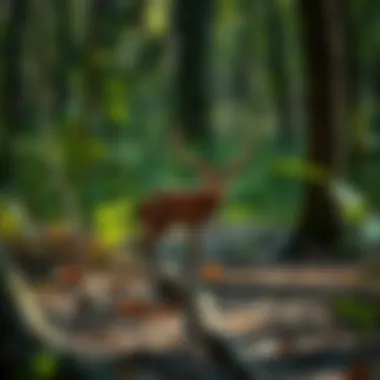Exploring the Florida Trail: History, Ecology, and Impact


Intro
The Florida Trail is not merely a footpath that winds through the state’s diverse landscapes. Instead, it serves as a crucial thread that connects Florida’s rich natural heritage, its history, and ongoing conservation efforts. In its essence, the trail encapsulates the dynamic interactions between human endeavors and the environment. As hikers traverse its length, they gain insights not only into the ecological tapestry of Florida but also into the challenges that threaten it. It stands as a testament to the preservation of ecosystems and a beacon for sustainable practices, inviting those passionate about nature, environmental stewardship, and responsible recreation to engage deeply with both the landscape and its history.
The journey through this article seeks to illuminate the intricacies of the Florida Trail, showcasing the ecological diversities that flourish along its route, while addressing the pressing issues that the trail faces. Additionally, the focus will be on the role that such trails play in enhancing our awareness of conservation, as well as fostering a culture of environmental consciousness.
Overview of Forestry Practices
Understanding forestry practices is paramount to appreciating the challenges and benefits associated with lands like those encountered on the Florida Trail. The health of these ecosystems is intertwined with the ways in which humans manage and utilize forest resources.
Importance of Foresting
Forests cover approximately 33% of Florida’s total land area, playing a pivotal role in climate regulation, habitat preservation, and water cycle maintenance. Through the carbon sequestration process, trees absorb carbon dioxide, helping to mitigate climate change. Furthermore, healthy forests are critical to sustaining wildlife habitats, providing sanctuary for diverse species that rely on these environments.
Types of Forestry Practices
There are various forestry practices that contribute to forest health and sustainability. Some prominent methods include:
- Selective Logging: This approach focuses on carefully choosing only certain trees to harvest, leaving the overall structure of the forest intact.
- Reforestation: Involves planting trees in areas where forests have been depleted, which can enhance biodiversity and stabilize soil.
- Agroforestry: Merging agriculture with forestry by integrating trees with crops or livestock, offering both ecological and economic benefits.
Each of these practices has its place and importance in the overarching narrative of forest management, significantly impacting landscapes like those the Florida Trail traverses.
Best Practices for Sustainable Woodland Stewardship
To ensure that forests remain vital and resilient, adopting sustainable woodland stewardship practices is essential. These practices not only support ecosystem health but also improve the experience of those who traverse the Florida Trail.
Principles of Sustainable Forestry
Sustainable forestry is grounded in principles that promote ecological integrity, social responsibility, and economic viability. Key tenets include:
- Conservation of Biodiversity: Protecting species and their habitats within forest ecosystems.
- Ecosystem Health: Maintaining and enhancing the natural processes that characterize forest ecosystems.
- Community Involvement: Engaging local communities in the management and conservation of forest resources.
Techniques for Land Management
Effective land management techniques include:
- Monitoring: Regular assessments of forest health and biodiversity to identify and address issues.
- Integrated Pest Management: Combining biological control methods with careful monitoring to manage pests without harming the ecosystem.
- Fire Management: Utilizing controlled burns as a natural means of forest rejuvenation, preventing larger, uncontrolled wildfires.
Innovative Techniques in Forestry
As time moves forward, so does our understanding of forestry, creating opportunities for innovative techniques to emerge. These advancements can significantly affect the management of areas like the Florida Trail, ultimately improving conservation efforts.
Latest Technological Advancements
The adoption of technologies such as remote sensing and geographic information systems (GIS) has revolutionized forestry practices. Such tools allow for:
- Mapping Vegetation: Providing detailed imagery that helps identify species distributions and health.
- Drone Surveys: Utilizing aerial data collection for efficient monitoring of large tracts of forested land.
Integrating Traditional Knowledge with Modern Science
Combining traditional ecological knowledge with contemporary scientific practices leads to holistic approaches that resonate well within local contexts. This coupling can yield enriched outcomes and support sustainable practices that honor cultural heritage while promoting conservation.
“Sustainable forestry is not just about the trees, but the community that sustains them.”
Overall, the Florida Trail embodies the complex interplay of these elements, being an essential part of Florida's ecological identity and conservation narrative.
Prologue to the Florida Trail
The Florida Trail stands as a testament to the intertwined nature of human creativity and the rich ecological tapestry of Florida. Spanning over 1,000 miles, it runs through diverse landscapes and habitats, serving as a vital resource for recreation, education, and conservation. The importance of understanding the Florida Trail lies not only in its role as a hiking path but also in how it showcases the state’s cultural and natural history. This section delves into the trail’s past and its geographical context, which helps illuminate its significance in the contemporary conservation narrative.
History and Development
The roots of the Florida Trail trace back to the 1960s, when passionate outdoor enthusiasts began to advocate for a continuous footpath that would connect various state parks, forests, and natural landscapes. In 1966, the fledgling Florida Trail Association was formed, signaling the beginning of a coordinated effort to construct what we now know as the Florida National Scenic Trail.
This development was not just about creating a walking route; it was an endeavor to highlight Florida's unique ecosystems and promote outdoor activity in a state known for its urban sprawl. Over the years, various sections have been developed, renovated, and maintained by volunteers and organizations dedicated to preserving this important natural resource. Notably, the trail was designated a National Scenic Trail in 1983, leading to increased awareness and support for its conservation.
Geographical Overview
Geographically, the Florida Trail weaves through a spectrum of environments, offering amazing sights and experiences. It meanders from the panhandle through the central part of the state and ends in the vibrant landscapes of the Everglades. The trail's path varies significantly, showcasing miles of sandy beaches, lush swamps, dense forests, and serene lakes. Each segment presents its own challenges and delights, enticing hikers with its beauty.
Some notable regions along the trail include:


- Big Cypress National Preserve: A vast watery wilderness, home to myriad species.
- Apalachicola National Forest: Featuring towering pines and rich underbrush, ideal for birdwatching.
- Ocala National Forest: Renowned for its crystal-clear springs and opportunities for camping.
This geographical diversity underscores the ecological importance of the Florida Trail, not just as a footpath but as a vital link connecting ecosystems that would otherwise remain isolated. It represents a corridor for wildlife and facilitates the movement of species, directly contributing to regional biodiversity.
"The Florida Trail is not just a hiking path; it is a lifeline for the ecosystems it traverses, promoting unity between nature and human ambition."
In understanding the historical and geographical contexts of the Florida Trail, one gains insights into its inherent value, which goes far beyond recreational use. It epitomizes a growing awareness of our responsibility to protect the natural landscapes that define our identity.
For further exploration into the Florida Trail's influence on conservation and recreation, consult the Florida Trail Association's website at floridatrail.org or check out the additional resources available on Wikipedia.
By recognizing its historical importance and geographical diversity, we position ourselves to better appreciate the ongoing narrative of the Florida Trail as a dynamic fusion of ecological significance and human endeavor.
Ecological Significance of the Florida Trail
The Florida Trail is not merely a pathway for recreation; it plays a pivotal role in maintaining ecological balance and biodiversity in the region. By traversing various ecosystems, it showcases the intricate relationships between flora, fauna, and the ever-changing landscape of Florida. This section dives deep into the ecological significance of the Florida Trail, emphasizing its contribution to biodiversity and unique ecosystems that flourishes along its route.
Biodiversity along the Trail
Flora Diversity
In Florida, the array of plant life is as striking as the state's landscape. The flora diversity along the Florida Trail is abundant, featuring over 1,000 plant species. Notable among these are the endemic varieties, which cannot be found elsewhere in the world. For example, the Florida coontie, a key native plant, plays a crucial role in the local ecosystem as it supports the lifecycle of the Zebra Longwing butterfly.
The key characteristic that makes flora diversity along the trail so essential is its role in promoting healthy ecosystems. Not only does it provide habitat for various wildlife, but it also aids in soil stabilization and water filtration. This is particularly relevant as more areas face the threat of urban development.
One unique feature of this flora diversity is the interaction it fosters. Different species rely on one another, forming networks that enhance resilience against climate change and other environmental pressures. These plant communities not only enrich the landscape but also contribute significantly to the carbon sink capacity of the region. With such diversity, the trail showcases itself as a beneficial choice for conservation efforts aiming to preserve unique ecosystems.
Fauna Species
The fauna species that inhabit the Florida Trail represent an impressive range of biodiversity. Among the species spotted regularly are the Florida black bear, gopher tortoise, and Panther – symbols of the state’s wildlife. Each species contributes uniquely to its ecosystem, be it through pollination or as predators that maintain the balance of life.
What stands out about the fauna along the trail is not only the variety but also the adaptations these animals have developed to thrive in diverse environments. The Florida black bear, for example, has adapted to both forested areas and swamps, making it a versatile inhabitant.
However, the unique features of these fauna also come with disadvantages. These species face threats from habitat loss due to development and climate change. Despite this, their presence along the Florida Trail emphasizes the importance of preserving these habitats for ecological health.
Unique Ecosystems
Wetlands
Wetlands constitute a defining aspect of Florida's geography, acting as nature's sponge in absorbing excess rainfall and filtering pollutants. The wetlands along the Florida Trail are a rich habitat for various birds, amphibians, and fish. They serve not only as breeding grounds but also as crucial feeding areas for migratory species.
A notable characteristic of these wetlands is their ability to act as flood control systems. This is essential in a state that experiences heavy rainfall. Unfortunately, wetlands are also among the most threatened ecosystems due to drainage and development. The protection of these areas along the Florida Trail becomes crucial in maintaining the region's water quality and biodiversity.
Dry Pine Forests
Contrasting with the lush wetlands, the dry pine forests along the Florida Trail tell a different ecological story. These forests, dominated by longleaf pine trees, showcase a unique habitat that houses various wildlife like the red-cockaded woodpecker and numerous understory plants. The dry forest's key characteristic is its fire dependency; periodic wildfires are necessary for the lifecycle of certain plants and help to maintain the ecosystem's health.
Among the advantages these dry pine forests offer are rich soils and habitats that assist wildlife adaptation. Yet, they face challenges from invasive species and human encroachment. As such, preserving the dry pine forests along the Florida Trail highlights the importance of fire management practices to sustain these ecosystems.
"The Florida Trail offers a unique opportunity to witness the delicate interplay of diverse ecosystems, each contributing to the larger tapestry of life in Florida."
Recreation and Tourism
The interplay between recreation and tourism on the Florida Trail makes it a crucial aspect of understanding its overall impact. The trail serves not only as a haven for wildlife but also as a destination for outdoor enthusiasts. With thousands of visitors trekking through its paths each year, it's more than just a scenic route; it’s a catalyst for local economies, fostering a sense of community and stewardship.
Hiking and Walking Opportunities
Trail Sections
One of the most significant components of the Florida Trail is its diversity in trail sections. The trail stretches across approximately 1,300 miles, winding through varied landscapes, including lush forests, swamps, and open fields. Each section boasts unique characteristics, making it a beneficial choice for both seasoned hikers and casual walkers.
For instance, the Big Cypress National Preserve section presents a mix of sawgrass wetlands and palm swamps, offering a distinct experience where one can appreciate the serene beauty of the ecosystem. This section is particularly popular for its unique wildlife encounters. Heavy rains and floods can make some trails inaccessible, but when conditions are right, the scenery is breathtaking.
Moreover, different sections cater to varying interests. Some may seek solitude amidst thick pine trees, while others might enjoy the hustle and bustle near urban settings, where local flora is supplemented by recreational facilities.
Difficulty Levels
Understanding difficulty levels is another key element that contributes to the trail's appeal. Each segment of the Florida Trail is labeled according to its challenge, from family-friendly walks to more strenuous hikes designed for experienced trekkers. This variety ensures that the trail remains accessible to a wide audience.
For example, sections like the Blackwater River State Forest provide easy-going paths suitable for anyone, including families with young children. On the flip side, sections like the Apalachicola National Forest demand more stamina and preparation, presenting a rewarding challenge with stunning vistas as a reward.
By acknowledging these levels, hikers can plan their journeys accordingly, ensuring that they select trails that match their skills and goals.


Cultural Events and Activities
Festivals
An essential aspect of the Florida Trail's role in the community is its connection to festivals. Various celebrations occur throughout the year, often highlighting local culture, history, and the trail itself. These events draw participants from all over, creating a vibrant atmosphere enriched with local traditions and ecological awareness.
Take, for instance, the Florida Trail Festival, which brings together enthusiasts who gather to celebrate the trail's spirit and significance. This festival is not just about hiking; it emphasizes outdoor skills, invites speakers who are experts in conservation, and showcases local artisans, adding layers of cultural richness to the experience. Festivals like these foster camaraderie, with newcomers easily mingling with veterans, resulting in shared stories and insights about hiking routes.
Community Involvement
Finally, community involvement stands out as a vital pillar supporting the Florida Trail. Local residents often engage with the trail, contributing to its maintenance through volunteering opportunities and community events.
Participation in trail clean-ups or educational programs allows individuals to connect with nature while fostering responsibility towards conservation. This hands-on engagement instills a sense of ownership and pride among the locals. Additionally, the initiatives designed to involve schools and local organizations help educate younger generations about the importance of the environment and trails.
This bidirectional relationship of community and trail enhances the understanding of environmental sustainability and strengthens communal bonds, ultimately enriching both the trail experience and its preservation.
"The Florida Trail is not just a path through nature but a journey connecting people with each other and the environment."
Various resources further enhance this understanding. For those keen on exploring the trail's history, ecology, and community impact, references like The Florida Trail Association and local governmental sites (*.gov) provide valuable insights.
In summary, the Florida Trail offers diverse hiking opportunities, celebrates local culture through festivals, and fosters community involvement. All these elements combined underscore its importance as a beloved resource for recreation and tourism.
Conservation Efforts
Conservation efforts surrounding the Florida Trail are a linchpin in ensuring the longevity and health of both the trail and the ecosystems it houses. Without dedicated actions focused on protecting this invaluable corridor, both flora and fauna may face irreparable harm. These efforts play a pivotal role in fostering biodiversity, preserving cultural heritage, and engaging the community. Consequently, understanding the conservation Endeavors helps not only in appreciation but also in participation, making it a critical aspect of the trail's narrative.
Organizations Involved
Nonprofit Organizations
Nonprofit organizations have a significant hand in the conservation landscape of the Florida Trail. Groups like the Florida Trail Association mobilize volunteers and resources, which is a key characteristic of their approach. Through grassroots efforts, these organizations often cultivate a deep sense of community, making them an emergent identity for conservation activities. The unique feature about these nonprofits is their ability to garner public interest and involvement, leading to substantial volunteer turnout for trail maintenance and habitat restoration projects.
Their impact, however, isn't without limitations. Often operating on tight budgets and reliant on donations, the financial constraints can restrict the scope of their activities. Still, they manage to leverage community spirit to raise awareness, and their commitment truly exemplifies dedication to preserving Florida’s natural beauty.
Government Agencies
Government agencies also play a vital role in the conservation of the Florida Trail. Organizations such as the U.S. Forest Service and the Florida Department of Environmental Protection administer policies and frameworks that support environmental integrity along the trail. A key characteristic of these agencies is their access to significant funding and resources, which allows for comprehensive projects that nonprofits may struggle with.
The unique feature of government involvement is the regulatory support it brings, ensuring that land use and conservation laws are upheld. While their bureaucratic nature sometimes slows down processes, their expertise provides a vital structure for long-term planning and effective conservation strategies.
Challenges Facing the Trail
Environmental Threats
Environmental threats to the Florida Trail encompass a range of factors, from invasive species to climate change. One of the most pressing issues is the encroachment of non-native plants, which often outcompete local flora. This pressure on biodiversity can significantly alter ecosystems along the trail. The characteristic resilience of the area's native species is both a hope and a challenge; efforts are needed to bolster this resilience through targeted intervention efforts.
Moreover, climate change poses significant risks, altering rainfall patterns and increasing temperatures that directly affect wildlife. The adaptability of the trail's ecosystems is under constant scrutiny, providing both a fascinating study and a grave concern for ongoing conservation work.
Funding and Maintenance
Funding and maintenance represent another challenge that plagues the efforts surrounding the Florida Trail. Financial support is crucial for trail upkeep, including routine clearing, signage installation, and overall public safety. Unfortunately, the disparity between the need for funding and the actual funds available can be staggering. Government allocations often fall short, leaving nonprofits to pick up the slack, which can stretch their resources thin.
This issue leads to another challenge: maintaining the civic engagement that is so essential for volunteer support. If people perceive the trail as neglected, the community enthusiasm may begin to wane. The unique aspect of this funding challenge thus lies in its circular nature—less funding leads to reduced maintenance and subsequently lowers community involvement, compounding the difficulties faced by conservationists.
"The resilience of the Florida Trail is not just a reflection of nature, but also of the people who fight to keep it thriving."
Sustainable Practices Promoted by the Trail
The Florida Trail serves as more than a simple pathway for hikers; it embodies a commitment to sustainable practices that protect the environment and ensure that future generations can enjoy its wonders. As recreational usage of the trail continues to rise, the importance of adopting eco-friendly habits becomes more paramount. This section delves into how sustainable practices, particularly eco-friendly hiking and community stewardship, significantly contribute to the preservation of the trail and surrounding ecosystems.
Eco-Friendly Hiking
Leave No Trace Principles
One key element in promoting sustainable hiking is the adoption of the Leave No Trace Principles. These guidelines, developed by the Leave No Trace Center for Outdoor Ethics, emphasize that outdoor enthusiasts should respect nature by minimizing their impact while exploring natural spaces. The principles cover aspects such as planning ahead, sticking to trails, and disposing of waste properly. Adhering to these principles is a clear pathway toward protecting the ecology of the Florida Trail.
A standout characteristic of these principles is their focus on education and awareness. By informing hikers about the consequences of their actions, they foster a collective sense of responsibility. For instance, hikers are urged to pack out all waste, from food scraps to toilet paper, which greatly reduces the trail's environmental footprint. This is not just a trendy choice; it promotes a long-standing culture of conservation on the trail.
However, it’s important to recognize that while these principles offer numerous advantages, they may also present challenges for some. For example, not all hikers are aware of these guidelines. Thus, proper education and outreach programs are essential to ensure that all trail users understand and embrace the Leave No Trace philosophy.
Local Wildlife Protection


Another fundamental aspect of sustainable practices is Local Wildlife Protection. On the Florida Trail, hikers encounter various species, and protecting these creatures is vital for maintaining the ecological balance. The initiative aims to safeguard habitats from disruptions caused by human activities. From monitoring nesting sites to ensuring that hikers do not disturb wildlife, the principles of local protection are critical to the overall health of the environment.
A vital characteristic of this practice lies in its proactive approach. Through guidelines and community awareness campaigns, hikers learn not to feed wildlife or encroach upon their natural habitats. By discouraging this behavior, the trail promotes a healthier interaction between humans and animals, creating a more sustainable ecosystem.
However, the enforcement of such protective measures can be tricky. Some visitors might ignore regulations due to a lack of awareness or understanding, leading to negative impacts on local wildlife. Ongoing education and visible signage along the trail can help mitigate these issues, fostering a culture that values wildlife protection.
Community Stewardship
Volunteering Opportunities
Community stewardship on the Florida Trail thrives through various Volunteering Opportunities. Local organizations often invite residents and hikers to participate in trail maintenance, clean-up days, and educational workshops. By engaging the community directly, these initiatives not only improve the trail's condition but also foster a sense of ownership among participants.
What stands out about volunteering is the bond it creates within the community. People come together with a shared goal—caring for the trail. This often leads to deeper connections to the environment and increased awareness of conservation issues. For instance, locals who volunteer regularly may take it upon themselves to educate others on the importance of protecting the trail.
Yet, challenges remain. While many individuals may want to contribute, they often lack time or resources, leading to inconsistent volunteer participation. Therefore, tailoring opportunities to fit various schedules and backgrounds is essential for better engagement.
Education Initiatives
Lastly, Education Initiatives play a pivotal role in promoting sustainable practices along the Florida Trail. Programs aimed at educating hikers, students, and the wider community about environmental conservation can have a lasting impact. Workshops, guided nature walks, and informational sessions serve to highlight the importance of the trail ecosystem and foster respect for nature among visitors.
These initiatives are particularly beneficial, as they create knowledgeable advocates for the environment. Individuals who understand the ecological significance of the trail are more likely to adopt sustainable practices themselves and share their knowledge with others.
However, the challenge lies in reaching diverse audiences. Not everyone is drawn to educational programs, and outreach must take many forms. Collaborating with schools, local businesses, and social media can help broaden the impact of these initiatives, ensuring that the message of sustainability resonates with a wide array of people.
"Preserving the Florida Trail is not just about maintaining a path; it’s about nurturing a connection with the land and understanding our role within it."
Future Prospects for the Florida Trail
The future of the Florida Trail lies at a crucial juncture, where hope meets challenge. As environmental awareness grows, discussions around the potential improvements and expansions of the trail become paramount. These future prospects are not just about enhancing recreational opportunities but also a means to energize conservation efforts. The road ahead involves an intricate dance of balancing ecological integrity with the demands of a growing populace that seeks outdoor experiences.
Long-Term Conservation Goals
In aiming for sustainable management of the Florida Trail, long-term conservation goals play a vital role. These goals are not just a wish list but rather strategic plans intended to guide the trail's development. The emphasis on preserving native ecosystems, safeguarding endangered species, and maintaining water quality reflects a commitment to protect the environments that hikers traverse.
Thinking long-term implies acknowledging the transient nature of some ecosystems. Therefore, goals should encompass habitat restoration initiatives that consider seasonal changes and climatic variability. Collaboration with local organizations, such as the Florida Trail Association and various environmental non-profits, is crucial. This partnership can foster educational initiatives and assist in community engagement projects aimed at creating stewards of the landscape.
Enhanced Trail Features
New Trail Expansions
The conversation surrounding new trail expansions isn't merely about creating more mileage. It's about connecting communities and promoting conservation. Expansions could introduce hikers to less-visited, yet ecologically rich areas.
One key characteristic of these expansions is their potential to showcase Florida's diverse habitats, from coastal estuaries to highland scrub. This exploration can offer unique ecosystems a chance to thrive, while also attracting visitors looking for new experiences. Expanding the trail not only invites outdoor enthusiasts but can also become a draw for eco-tourism, which benefits local economies.
However, there can be drawbacks. Introducing more hikers into delicate areas runs the risk of overuse and potential degradation of sensitive regions. That’s where sustainable planning comes into play, ensuring that human footprints leave only minimal impacts.
Technological Integrations
Integrating technology into the Florida Trail experience is another forward-looking initiative. Enhanced digital maps, mobile applications, and geolocation services can help hikers navigate with ease, while also supporting conservation efforts. For example, a mobile app could feature real-time updates on trail conditions, wildlife sightings, and areas that require special attention.
Moreover, this technological facet enables hikers to adopt sustainable practices. Features like geo-tagging can generate data that assists in monitoring trail usage and identifying hotspots needing attention. Such tools empower users to engage in trail maintenance indirectly by reporting problems they encounter.
Yet, while technology offers many advantages, reliance on gadgets can lead to disconnection from the natural world. Balancing the use of technology with the intrinsic value of nature is essential, ensuring that the trail's spirit remains intact.
"The future of the Florida Trail hinges not just on its physical path but on the preservation of the ecosystems it runs through and the community giving it life."
Finale
Reflecting on the Florida Trail gives us an in-depth appreciation of the beauty and complexity embedded in its existence. This trail is not just a ribbon of dirt winding through woods and wetlands; it serves as a living testament to Florida's rich ecological heritage and the ongoing interaction between nature and humanity. As traversers of the trail, one can observe how the landscape changes, revealing different ecosystems that flourish alongside human activities. The diversity of flora and fauna along the path underscores its role as a critical habitat, making it a vital link in the larger environmental narrative of the region.
Yet, this marvel comes with challenges that cannot be overlooked. Each step taken along the Florida Trail carries the weight of historical significance and contemporary issues alike. From conservation endeavors to the impacts of tourism, the trail stands at a crossroads, where the decisions made today will shape its future.
The Florida Trail represents a fusion of leisure, conservation, and education, offering an immersive experience that encourages environmental stewardship.
Reflecting on the Florida Trail
When we take a moment to reflect on the Florida Trail, several key elements emerge. First, the historical backdrop of the trail relays a story of human commitment to coexist with nature. Established as part of a broader vision for hiking and outdoor recreation, it symbolizes a shift in societal values towards conservation and environmental awareness. The people, organizations, and communities that have forged this path highlight a collective effort to preserve the unique ecosystems of Florida.
Moreover, the trail signifies critical opportunities for education and enlightenment. Each section provides information about its flora and fauna, drawing attention to the necessity of preservation and respect for biodiversity. The numerous interpretive signs scattered along the trail enrich the hiker's journey, emphasizing the interconnectedness of life in this unique environment.
Call to Action for Preservation
Given the importance of the Florida Trail, a call to action for preservation rings louder than ever. It is up to us—hikers, environmental advocates, local communities, and policymakers—to champion the initiatives that safeguard these precious ecosystems. Supporting local conservation organizations or volunteering for trail maintenance are meaningful ways everyone can contribute. Small gestures, like adhering to "Leave No Trace" principles, have a considerable impact on the long-term health of the trail.
Communities surrounding the trail play a pivotal role, too. By participating in educational initiatives and cultural events, residents can deepen their ties to the land. Raising awareness about the trail's ecological significance is paramount. Social media platforms like Facebook and Reddit can serve as channels to spread the word, encouraging a wider audience to engage with the trail responsibly.
Ultimately, preservation efforts need backing. Lobbying for funding from government agencies and forming partnerships with nonprofits can create a robust support network. Initiatives that spark enthusiasm about the trail can lead to more sustainable practices and long-lasting conservation efforts, ensuring the Florida Trail remains a cherished resource for generations to come.















